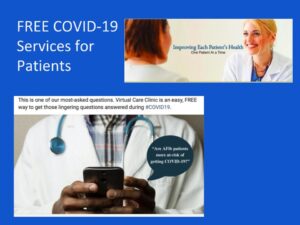By Michael Wong (Founder/Executive Director, Physician-Patient Alliance for Health & Safety), Lynn G. Razzano, RN, MSN, ONC, CMSRN (Clinical Nurse Consultant, PPAHS), and Thereza B. Ayad, RN, MSN, DNP, CNOR (Clinical Nurse Consultant, PPAHS)
Virtual Patient Care Launched to Help Patients
We started Virtual Patient Care to help patients during the current COVID pandemic. Helping patients is what motivated BMS-Pfizer Alliance to provide us with grant support. Helping patients is why the American Heart Association, AC Forum, Heart Rhythm Society, StopAfib.org, Mended Hearts, and Preventive Cardiovascular Nurses Association have provided such great support and help for Virtual Patient Care. To read the press release on Virtual Patient Care, click here.
Since we launched Virtual Patient Care, we have received many questions from patients asking us to diagnose their ailments or asking us to explain why a certain treatment or medication isn’t curing them.
Tips if You are Underinsured or Uninsured
To answer these questions, we have recommended that people contact their doctor. However, we fear that such advice, although sound, may simply not be practical for many patients.
We suspect that many, if not all of these questions are coming from patients who are underinsured and uninsured. Hospitals see many patients with very high deductibles that can’t seek care until their insurance deductible is met. They have insurance, but they simply can’t afford to pay for medical care or their prescriptions.
Patients seeking diagnosis of what ails them may be hoping that a free service may provide them answers to their medical conditions or medications without having to pay for co-pays to see their doctor or incur other expenses they might not be able to afford. According to the United States Census, in 2018, 27.5 million Americans did not have health insurance at any point during the year. What is particularly frightening during the current COVID pandemic, for which the elderly are more at risk, is that elderly Americans are more likely not to afford care.
We hope that we are wrong and that everyone has health insurance, but in case these questions are coming from those who can’t afford to ask their doctor or don’t even have a doctor, here are some things that you can do:
Need to Know What Ails You?
If you are having a medical emergency, please call 911. If you are concerned that you may get COVID, the American Heart Association (together with Association of Black Cardiologists, American College of Cardiology, American Academy of Neurology, American College of Emergency Physicians, Heart Failure Society of America, Heart Rhythm Society, and Society of Cardiovascular Angiography & Interventions) advises you to call 911:
“You might think a hospital is the last place you should go now. That’s why we – the leaders of major national organizations dedicated to saving people from heart disease and stroke – feel it’s necessary to say this loud and clear:
“Calling 911 immediately is still your best chance of surviving or saving a life.
“It is SAFE for EVERYONE to call 911.
“It is SAFE for ANYONE to go to the hospital.”
If for whatever reason, you can’t afford, don’t have health insurance, or had health insurance but now can’t afford your premiums, please contact Medicaid:
Medicaid is a joint federal and state program that, together with the Children’s Health Insurance Program (CHIP), provides health coverage to over 72.5 million Americans, including children, pregnant women, parents, seniors, and individuals with disabilities. Medicaid is the single largest source of health coverage in the United States.
To participate in Medicaid, federal law requires states to cover certain groups of individuals. Low-income families, qualified pregnant women and children, and individuals receiving Supplemental Security Income (SSI) are examples of mandatory eligibility groups (PDF, 177.87 KB) . States have additional options for coverage and may choose to cover other groups, such as individuals receiving home and community-based services and children in foster care who are not otherwise eligible.
The Affordable Care Act of 2010 created the opportunity for states to expand Medicaid to cover nearly all low-income Americans under age 65. Eligibility for children was extended to at least 133% of the federal poverty level (FPL) in every state (most states cover children to higher income levels), and states were given the option to extend eligibility to adults with income at or below 133% of the FPL. Most states have chosen to expand coverage to adults, and those that have not yet expanded may choose to do so at any time. See if your state has expanded Medicaid coverage to low-income adults.
Many non-profits run free or low-cost health clinics. Check local listings in your area.
Why Isn’t My Medication Curing Me?
If you have questions about any medications prescribed to you, such as, why they aren’t working or are causing you to have an adverse reaction, one person you can ask is the pharmacist who dispensed it. It is estimated that at least 1.5 million preventable adverse drug events occur within the healthcare system each year and that this costs our healthcare system more than $4 billion annually.
Pharmacists are a great resource for how medications are interacting. They can explain why you may be having a particular reaction or no reaction to a particular medication. Pharmacists can also do a medication reconciliation, which is a process of comparing your prescriptions with any other prescriptions you may have. It is estimated that 25 percent of people between 65 and 69 take at least five prescription drugs to treat their chronic conditions. Completing a medical reconciliation is a great way to avoid medication errors such as omissions, duplications, dosing errors, or drug-to-drug interactions.
However, if you are taking several medications (called polypharmacy), please don’t stop taking them. Here’s some great tips if you suspect polypharmacy may be the cause of your medications not working.
I Can’t Afford My Prescription
If you can’t afford your prescription, for information on medication assistance and patient assistance programs, go to https://www.needymeds.org/
For specific drugs you may be taking, most pharmaceuticals have patient assistance programs – for example, if you are taking Eliquis, Opdivo, and Orencia, the Bristol Myers Squibb patient assistance programs can be found here.
Ask Virtual Patient Care
If you have any questions, ask Virtual Patient Care.
If we can’t answer your question, we just might be able to steer you in the right direction or to resources that might be of help.



great work thank you for sharing